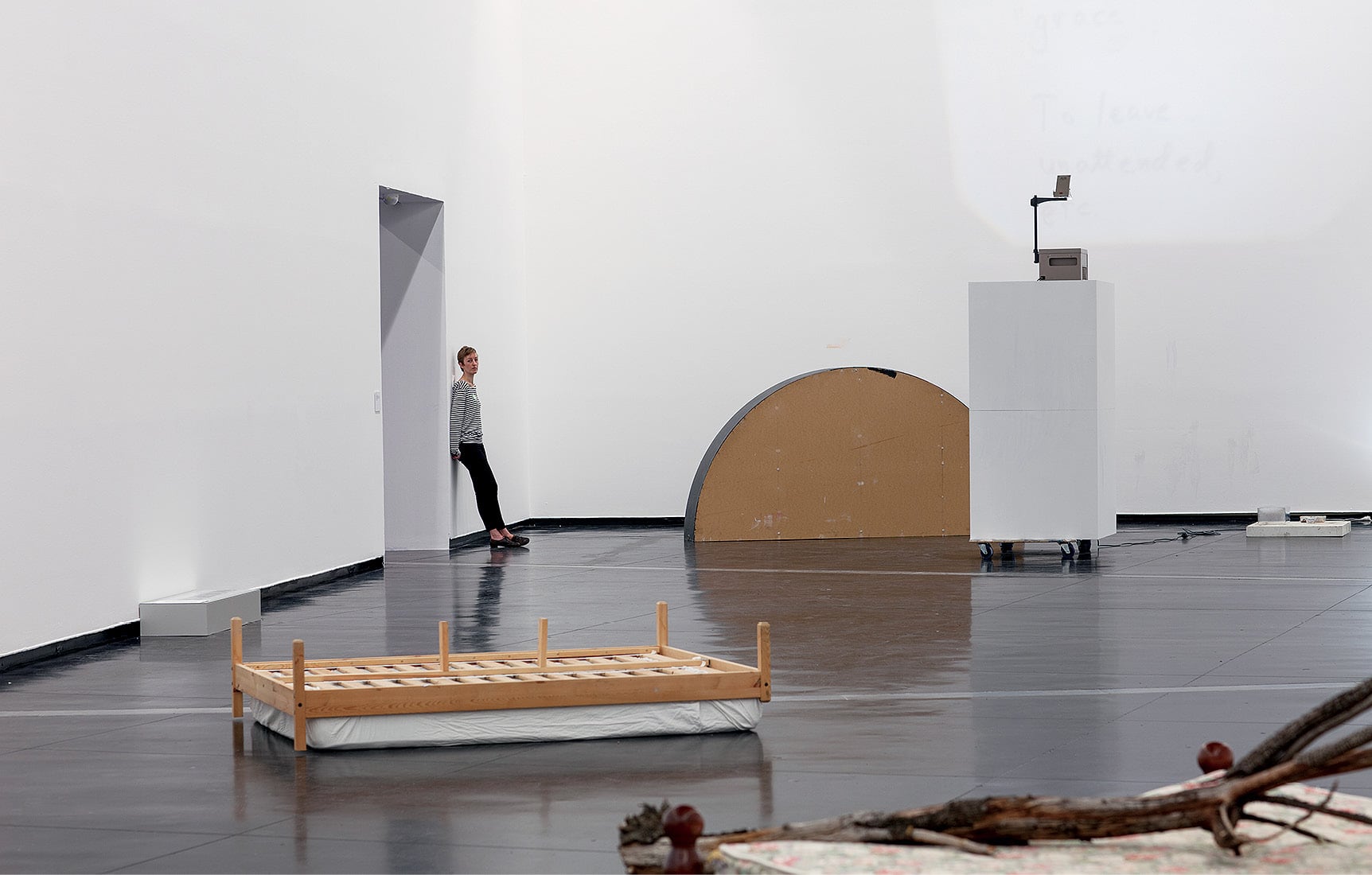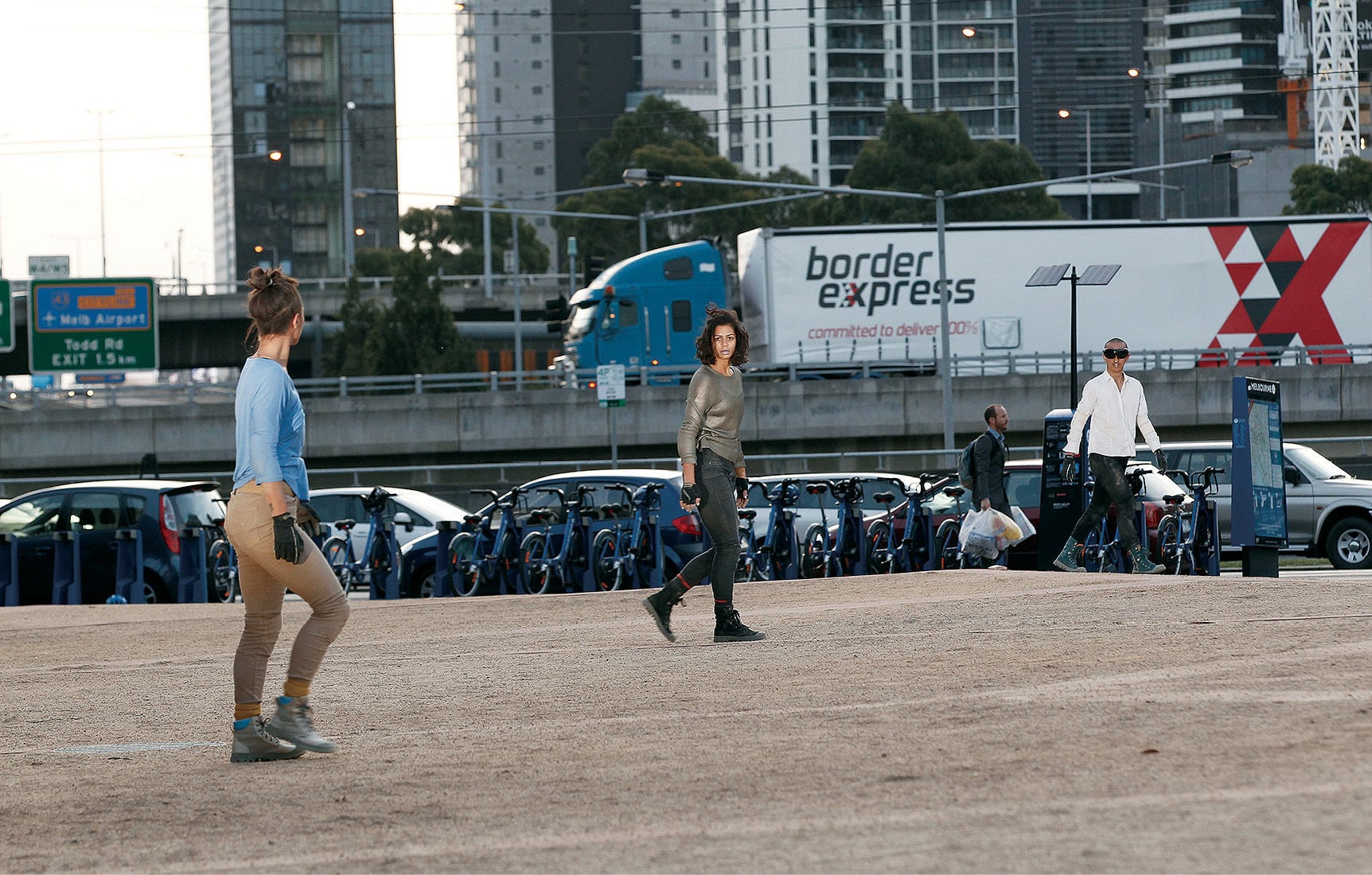
Consider the out-of-focus faces in the background of a crowd scene. Outnumbering the key players twenty to one, they go unseen and unannounced. What would it mean to adjust the depth of field and throw the background actors into sharp relief? My line of inquiry is concerned with the possibility of using inconspicuousness as a strategy for subversion and resistance, and I will examine the figure of the ‘extra’ in recent work by Jess Olivieri and Hayley Forward, Jessie Bullivant and Anouk Van Dijk.
The extent to which the extra in a performance context interacts with the extra in a sociopolitical context—that is, those voices not privileged by whiteness or maleness, for example, is also of considerable interest here. Can this strategy of locating and engaging with marginal or invisible modes of agency by artists and performers be used as a model for potential sociopolitical implications of speaking from a lateral position? Can ‘not being seen’ actually operate as a mode of resistance to hierarchical systems of classification and oppression within the art institution and beyond?
A Monty Python sketch titled
How Not To Be Seen opens with a serene wide shot of an apparently uninhabited landscape. The narrator announces, ‘In this picture there are 47 people. None of them can be seen.’ One of these people is Mr E. R. Bradshaw of Napier Court, Black Lion Road, London SE 5. The narrator asks him to stand up. He complies and is immediately shot. According to the narrator, ‘This demonstrates the value of not being seen.’
Hito Steyerl’s *HOW NOT TO BE SEEN: A F*
king Didactic Educational .MOV File borrows part of its title from the same sketch. As Leora Morinis, Curatorial Assistant at the Museum of Modern Art New York, notes in relation to Steyerl’s work, ‘focusing on how-not-to rather than any single affirmative concept, like “invisibility,” allows for broader scope. Certainly, you can not-be-seen because you are invisible, but you could also not-be-seen simply because someone is looking elsewhere, and so on.’
But how does one go about locating and occupying this blind spot? In other words,
how not to be seen?
Enter Jess Olivieri and Hayley Forward. In 2012, the artists collaborated with Gallery Services Officers (GSOs) at Queensland Art Gallery and Gallery of Modern Art (
qagoma) on a performance titled
Canon. The performance involved the GSOs wearing tap shoes instead of their regular dress shoes for the duration of the exhibition. In an interview with
qagoma, Olivieri describes the GSOs as the ‘invisible human architecture’ of the institution. This intervention in the footwear of the GSOs makes their movement audible, in turn making their presence more visible. In other words, the GSOs—formerly extras in the background of the scene—become the stars of the show.
Jessie Bullivant’s contribution to
NEW15 at the Australian Centre for Contemporary Art (
ACCA) also engaged with the ‘invisible human architecture’ of the art institution. The work, titled
Inside Job, involved a simple instruction from the artist to the invigilators of the gallery: a shrug, to be performed in the course of each interaction with members of the public. As Tara McDowell writes in her catalogue essay
The Insider, ‘Bullivant’s refusal (its “I don’t know” or “I won’t say” or “I don’t care”) is a careful attempt to maintain uncertainty.’
^5
In an essay titled ‘Exhaustion and Exuberance’ Jan Verwoert proposes the notion of ‘existential exuberance’ as a way to ‘interrupt the brute assertiveness of the I can through the performance of an
I can’t performed in the key of the
I can’. This de-privileging of the impetus to perform does not reflect a shying away from the spotlight, but rather a methodology of resistance to the culture of high performance that demands a state of constant readiness. As Verwoert argues, forms of agency associated with acts of resistance typically involve grand gestures of revolt, and there, ‘actually exemplify the core momentum of high performance itself: [to] make something happen and deliver an event’. Therefore, he calls for ‘silent but effective’ forms of non-alignment and non-compliance in art and thinking.
Bullivant’s shrug (her I don’t know, I won’t say, I don’t care) is as an example of Verwoert’s
I can’t performed in the key of the
I can. Typically, a shrug is a gesture of dismissal or doubt. It is, by nature, unassertive. However, in
Inside Job, the shrug is performed as an assertion—here the invigilators perform the negative proposition in the key of the positive proposition. In addition, the uneventfulness of the gesture means that it may not be recognised as a performance at all. As McDowell writes, ‘Blink and you might miss it. Jessie Bullivant’s work in
ACCA’s galleries is nearly invisible.’ Nearly invisible, but not quite—Bullivant’s shrug does exist, however it does so in a blind spot. Due to the fact that the performer is camouflaged within the identity of invigilator, theirs is a role that is itself absorbed into the architecture of the institution.

Choreographer Anouk van Dijk investigates the possibilities afforded by the blind spot in a piece titled
Depth of Field, presented by Chunky Move, which took place in the
ACCA forecourt over a series of evenings in March, 2015. Ostensibly, the performance consists of Chunky Move dancers James Vu Anh Pham, Tara Jade Samaya and Niharika Senapati interacting with each other and around the architecture of the space in a choreographed routine. The dancers are flanked by audience members on a purpose-built grandstand, as well as by curious onlookers and people who happen to be walking through the public space. About halfway through the performance the three dancers fall to the ground in unison. At this same moment a cast of ten or so hitherto seemingly innocuous passers-by also fall to the ground. This moment marks a critical juncture in the performance because it promotes the extras or ‘plain-clothes’ performers from the background to the centre of the ‘stage’.
In this way,
Depth of Field creates a rupture in the binary of figure and ground. This action of ‘leveling’ the field by bringing all performers to the ground in unison means that figure and ground are no longer separate frames but rather two ends of a spectrum, connected, as it were, by a focus zoom that can thereafter be adjusted by the audience. On this spectrum, between the shallow and the deep, there emerges an intermediate zone: a middle ground between being seen and not being seen. This is the space that van Dijk’s extras occupy prior to their ‘unveiling’, and where Bullivant’s invigilators and the
qagoma’s GSOs also reside. This channel that opens up in the space between conspicuous and inconspicuous provides the conditions for a minor part to subvert the logic of a performance, since it is here that the
I can’t and the
I can overlap.
Can the strategy of these artworks, whereby ‘not being seen’ is the condition that enables the figure of the extra to undermine the systems that overlook it, actually provide a model for socio-political contexts? Is the figure of the extra, as outlined, analogous to the subject of systematic or institutional oppression in the ‘real world’? At the very least, these artworks generate a heightened lateral awareness that stays with us beyond the experience of the work. At most, perhaps, the empowered extra demonstrates how to assert the blind spot as a position of authority—how, when the dominant voices say
you can’t and
you won’t and
you’re not, to speak back from an elsewhere:
I can and I will and
I am.
Georgia Robenstone is an artist and writer based in Melbourne.
[^9]: Anouk Van Dijk,
Depth of Field, 2015, Chunky Move and Malthouse Theatre, Melbourne.


